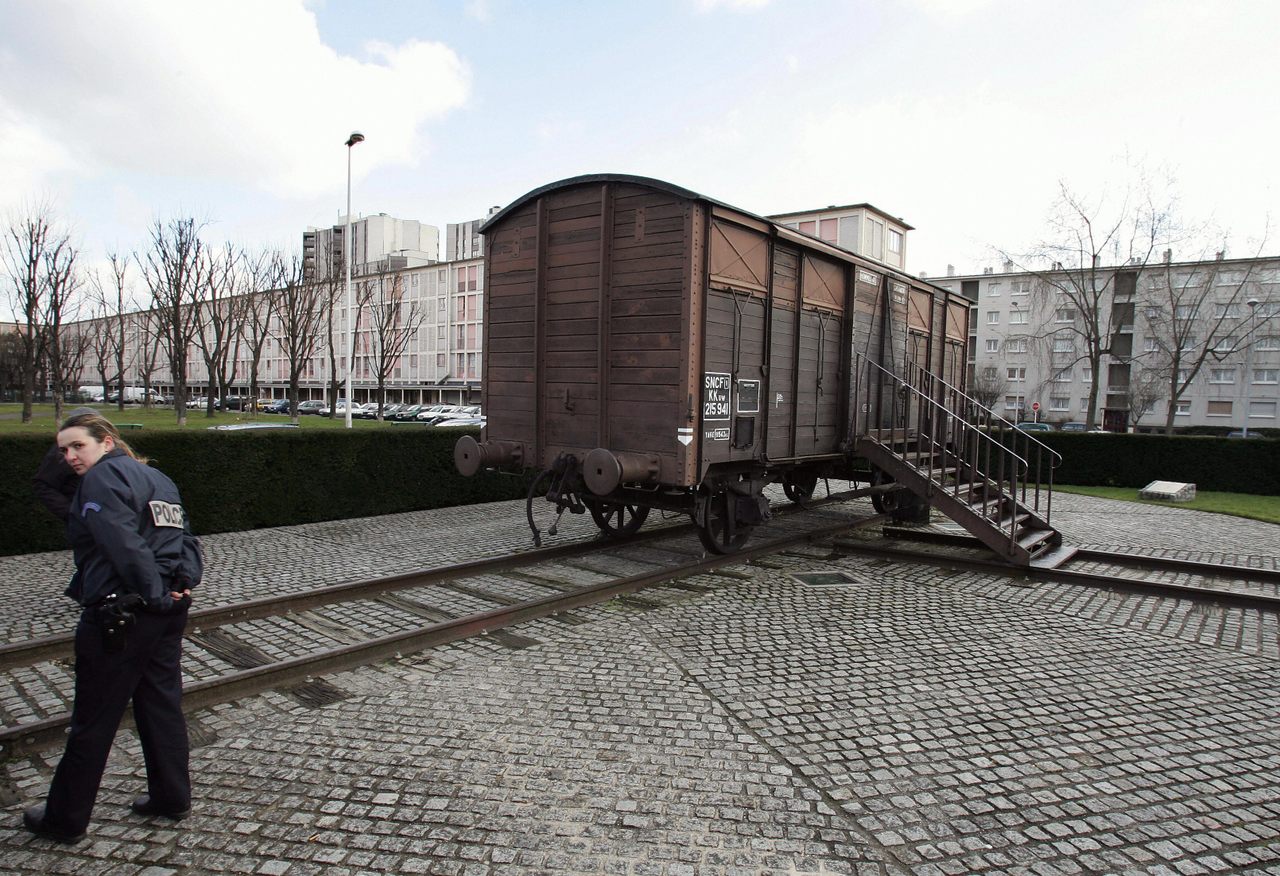The Dark Past and Unsettled Present of a Paris Housing Project
“Drancy is like the French bad conscience.”
It has been a time of particular unease in Paris, and the signs are everywhere. Tear gas has clouded the Champs-Élysées. Swastikas have been scrawled on public portraits of the French Jewish politician Simone Veil. Notre Dame burned. In the suburb of Drancy, a few miles northeast of the city, things are almost eerily calm, but the sense of malaise seems to carry. There, when you step off the bus at Liberation Square, you’re greeted by a U-shaped concrete building that partially encloses a wide-open grass courtyard. This pale yellow apartment block has changed from an affordable housing complex to an anteroom of death and back again in less than a century.
In the early 1940s, Nazis and their French collaborators rounded up more than 60,000 French Jews and held them here before dispatching them to death camps in what is now Poland, including Auschwitz and Sobibor. In the apartment complex—conceived just a decade earlier as a model for urban living— internees were hemmed in by barbed wire, wore yellow stars marked “Juif” (“Jew”), and suffered from dysentery and other diseases. Almost all of the people who passed through the camp, also referred to as Drancy, then died in the Holocaust. But the rooms they were interned in remain, now occupied by a new generation of people on the margins of French society.
The Germans called Drancy a “durchgangslager” or “transit camp”—“durchgang” meaning “the way through.” Nearly eight decades later, the repurposed housing complex remains a place of transit and transition. It houses immigrants, the working poor, and others who are looking for a way to their own version of belonging. To find it, they must contend with Drancy’s legacy—not just the atrocities it will always carry, but also age-old conceptions of Frenchness that nudge many to the periphery.


There was a time when the Drancy housing complex was all optimism. Its pre-war planners saw the project as the pinnacle of 20th-century living. French architects Marcel Lods and Eugène Beaudouin hoped to provide safe, affordable housing to as many city-dwellers as possible. The four-story U-shaped building that served as the wartime Drancy camp was erected in the 1930s, and construction had begun on five 14-story towers adjacent to it, packed with studios and one-bedroom apartments. “Before the war, there were postcards of those towers,” says Benoit Pouvreau, a historian at the Department of Cultural Heritage in Seine-Saint-Denis, the region where Drancy is located. “It was a symbol of modernity.” Altogether, the development consisted of 1,200 units.
The planners dubbed it Cité de la Muette (The Silent City), evoking the peace and quiet residents would find within. But this sanctuary never materialized. Soon after conquering Paris in 1940, the Nazis took over the still-unfinished housing complex and converted it to the primary French staging ground for their campaign against Jews. The name Cité de la Muette remained relevant in a different way—the complex became a city of the voiceless.
After World War II, many of the buildings stood empty for a long time. In the 1970s, they were pressed back into service as French army housing, but this revival didn’t last. Most of the complex, including the imposing 14-story towers, was knocked down in 1976. The only building spared was the U-shaped “horseshoe” that had served as the internment camp.
More than 70 years after the end of the war, the surviving building at least nods toward Lods and Beaudouin’s original intent, as public housing for the area’s most vulnerable residents. But it’s hardly a modern paradise. In the foreground of the block-long courtyard, a single train car—the same kind used to move Jews to Auschwitz and other camps—sits on a displaced section of track as a memorial. Jungle-green birds, most likely invasive ring-necked parakeets, huddle in the top branches of a clump of courtyard trees, transplants from warmer climates somehow thriving in northern France.

During the war, the horseshoe building’s layout was the same as it is today: a series of evenly-spaced doorways at ground level, each of which opens onto a salt-and-pepper-tiled lobby and four flights of stairs. Apartments cluster at each landing. Nowadays, each small apartment might house a single family, but back in the 1940s, as many as 50 to 60 Jewish inmates were crammed into each unfinished room. Some were seized off Parisian streets in surprise roundups and arrived at the camp without even a change of clothes—a situation they could not remedy, since detainees were often not allowed to receive packages.
According to historian Renée Poznanski’s Jews in France During World War II, the camp management supplied one bar of soap for every 10 inmates, and a single faucet in each room trickled washing water into a wooden trough. Every day, and sometimes twice a day, inmates were herded out of their rooms for long roll calls in the courtyard. Barbed wire ringed the building and courtyard.
The courtyard now has an expansive, open feel, closer to the clean, minimal space the planners and architects were aiming for. Still, there are clear visual specters. There’s the massive boxcar—one of the first things you see as you arrive—and a memorial of pink granite pillars that form the Hebrew letter shin, signifying the name of God. As you walk toward the stacked apartments, it’s hard not to imagine what once filled this space: tinny loudspeakers, the long latrines where prisoners could exchange bits of information, the fleets of buses that ferried prisoners to Bobigny or Le Bourget train stations, where they were shipped off to Auschwitz.

During the war, some of the building’s entryways were designated “deportation stairwells,” to be used only by prisoners marked for immediate removal. The rest were to remain at the camp for a few weeks or months before it was their turn. Today, these entryways are all supposed to stay locked, accessed only by residents coming in and out. On a chilly day not long ago, one of the faded pink doors was propped a little, and gives way to a gentle push.
The odor of mildew hangs over the interior, followed by a chaser of urine. Shallow craters pock-mark paint layers on the walls and banisters, and some of the stair risers have chunks missing. The scene recalls any number of public housing projects past and present, from austere council flats in London to high-rises in Chicago. While most of Chicago’s original projects have met with the wrecking ball, the Drancy “U” will likely remain standing for years in some form, as the French Ministry of Culture recognized it as historically significant in 2001.
Relatively few locals besides the residents ever visit the Drancy site, but it does host a steady trickle of visitors from farther away—relatives of camp victims, the odd historian or journalist. Understandably, the people who live there are wary of outsiders, who tend to ply them with questions. “People [in] Drancy have always lived with that,” Pouvreau says. “The questions make them feel guilty for being there.”

“It’s better to live here than somewhere less nice,” says a red-haired woman toting a torso-sized shopping bag, who does not want to give her name. She says she’s lived at the complex for 50 years. Asked how the place has changed over time, she starts to get fired up. Prostitutes work in front of the complex now, she claims. She called the police just the other day to report what is going on. “It’s not a community,” she says, her voice rising. “It’s a brothel.”
“It’s a good place for families,” says Brahim, who emigrated from Algeria 14 years ago and recently moved to the complex. He’s aware of the place’s history and thinks it’s important to keep it alive. “We must keep it,” he says with conviction, switching from French to English. “We cannot put it out.”
Just across the street from the courtyard is a busy café that sells high-voltage espressos for €0.50. The regulars around the counter are willing to ponder Drancy’s legacy. Kamel, who’s also from Algeria, says that a lot of locals don’t want to live at the complex because they don’t want to be associated with its past. In fact, he says, his sister turned down an apartment there. “She refused, because she knew it was a kind of prison.”
After the complex was listed as a historic monument, the regional government carried out some restoration projects. As old doorways were being refurbished, workers found messages from deportees scratched onto some of the original plaster wall panels. These panels, along with other artifacts and stories, are now housed at a new museum next to the café. Some comment on life in the camp—one reads, “The toilet is forbidden after 10:00.” Others are desperate voices in the dark, recording writers’ names and deportation dates: “Lonker Otton / Lonker Mindel, deported February 11th, 1943, destination unknown.”

Compared to the apartment building, the Mémorial de la Shoah de Drancy museum—subsidized by France’s foundation for Holocaust remembrance—feels pared-down and immaculate. Its glass facade offers a panoramic view of the housing complex and courtyard below. On one of the weekly museum tours, the guide narrates Drancy’s history and its Nazi-guided evolution into a transit camp. The main gallery features dozens of period artifacts, from letters prisoners wrote after their arrest to pencil sketches of camp life by interned Jewish artist Georges Horan. There is also a precise scale model of the camp in bright white. But the tour does not venture into the complex itself—the place where people live and where others were crammed dozens to a room, as they waited to hear if they would be sent to “destinations inconnues,” or “unknown places.”
Near the end of the tour, discussion turns to who was responsible for what happened at Drancy during the war. The guide explains that while the Nazis set up the transit camp, French collaborators helped carry out its deadly mission. The guards at the camp, she says, were French armed police. At this point, people on the tour start to look uncomfortable. “It was the occupiers,” one woman objects.
The uneasiness about French complicity at Drancy, as well as the current conditions at the complex, suggest a broader national reluctance to confront the calculus of social exclusion. “Liberté, égalité, fraternité” have defined French identity since the revolution in 1789, but in recent years a vein of intolerance that long pulsed below the surface has begun to bleed into the streets.

Periodic hate crimes tend to make the news—such as the stabbing of 85-year-old Holocaust survivor Mireille Knoll in her apartment in 2018—but there is a broader attitude that parallels the rise of the far right all over Europe and the world. In France, it takes its most public form with Marine Le Pen and her National Rally party. It is a discomfort with things and people seen as not-French-enough, some of whom now occupy the Drancy complex. These days, Parisian suburbs like the one where the former camp is located are largely populated with North Africans and other minorities, who remain literally and figuratively on the outskirts of city life.
In a 2018 survey by French polling firm IFOP, 58 percent of French respondents were opposed to the influx of immigrants. Only 30 percent saw immigration as positive for France, down 10 points from just three years earlier. Le Pen, when she ran for president, billed herself as “not against immigrants, just against immigration.” The infamous anti-establishment “yellow vest” protests, too, are largely white. Minorities, according to news outlets such as Al Jazeera, tend to stay away so they won’t be branded as troublemakers.
In Drancy, it’s hard to escape the uneasy, slightly alarmist thought that history is a wheel, that the increasing fervor of anti-immigrant rhetoric is leading people down a familiar and dark path. People around the complex might assure you nothing like the Holocaust could happen again, but how possible did such a thing ever seem? In its quiet way, the Cité de la Muette testifies to that level of guilt, disbelief, and concern for the future. “Drancy,” says Pouvreau, the historian, “is like the French bad conscience.”
























Follow us on Twitter to get the latest on the world's hidden wonders.
Like us on Facebook to get the latest on the world's hidden wonders.
Follow us on Twitter Like us on Facebook